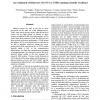Free Online Productivity Tools
i2Speak
i2Symbol
i2OCR
iTex2Img
iWeb2Print
iWeb2Shot
i2Type
iPdf2Split
iPdf2Merge
i2Bopomofo
i2Arabic
i2Style
i2Image
i2PDF
iLatex2Rtf
Sci2ools
DSD
2009
IEEE
2009
IEEE
An Evaluation of Behaviors of S-NUCA CMPs Running Scientific Workload
Modern systems are able to put two or more processors on the same die (Chip Multiprocessors, CMP), each with its private caches, while the last level caches can be either private or shared. As these systems are affected by the wire delay problem, NUCA caches have been proposed to hide the effects of such delay in order to increase performance. A CMP system that adopt a NUCA as its shared last level cache has to be able to maintain coherence among the lowest, private levels of the cache hierarchy. As NUCA caches typically adopt a NoC as the communication infrastructure (in which the communication paradigm is message-passing), the coherence protocol has to be directory based, similar to the ones proposed for classical DSM systems. Previous works focusing on NUCA-based CMP systems adopt a fixed topology (i.e. physical position of cores and NUCA banks, and the communication infrastructure) each adopting different coherence strategies. In this paper, we present an evaluation of an 8-cpu CM...
Coherence Protocol | DSD 2009 | Hardware | Level Cache | NUCA Caches |
| Added | 16 Aug 2010 |
| Updated | 16 Aug 2010 |
| Type | Conference |
| Year | 2009 |
| Where | DSD |
| Authors | Pierfrancesco Foglia, Francesco Panicucci, Cosimo Antonio Prete, Marco Solinas |
Comments (0)

